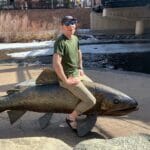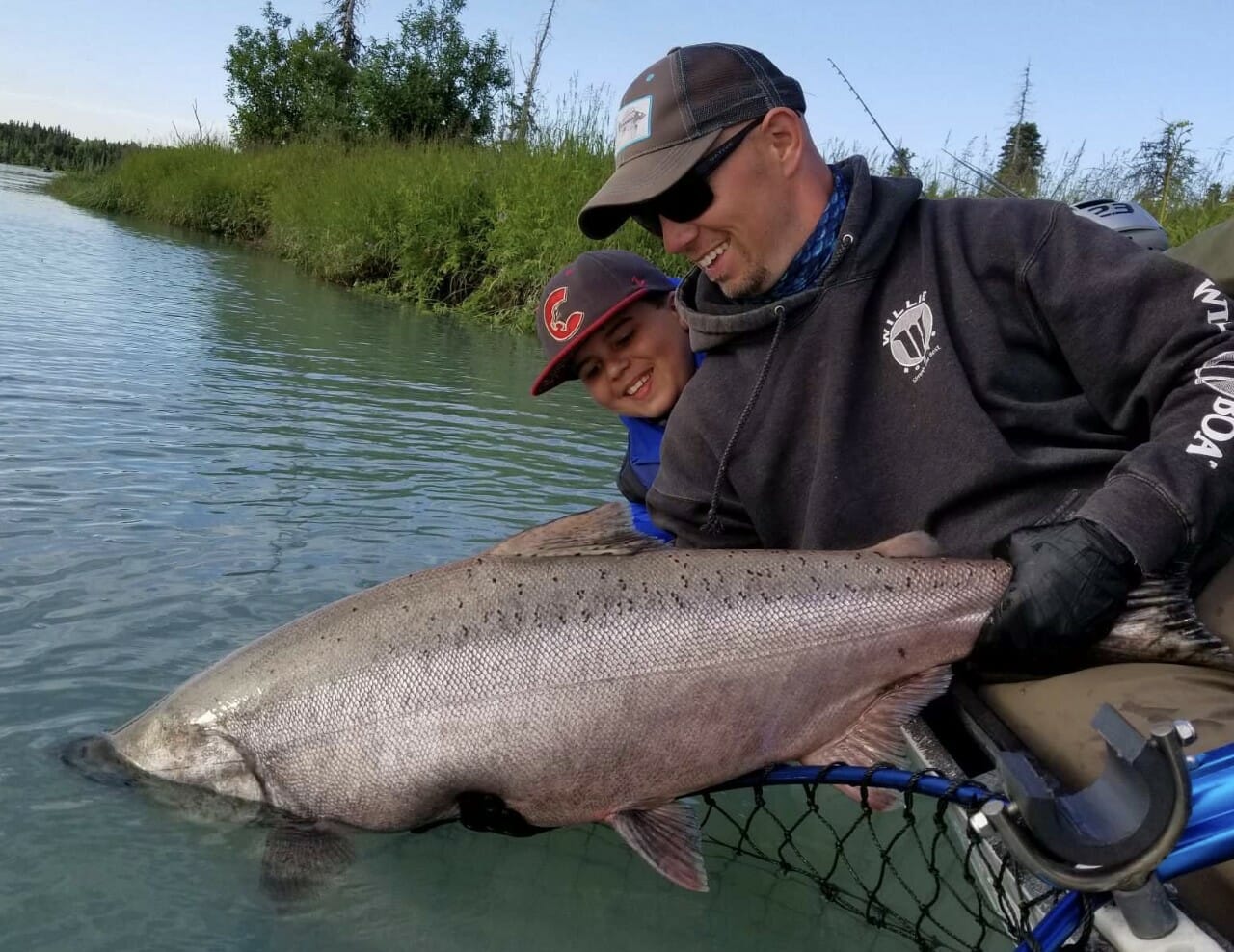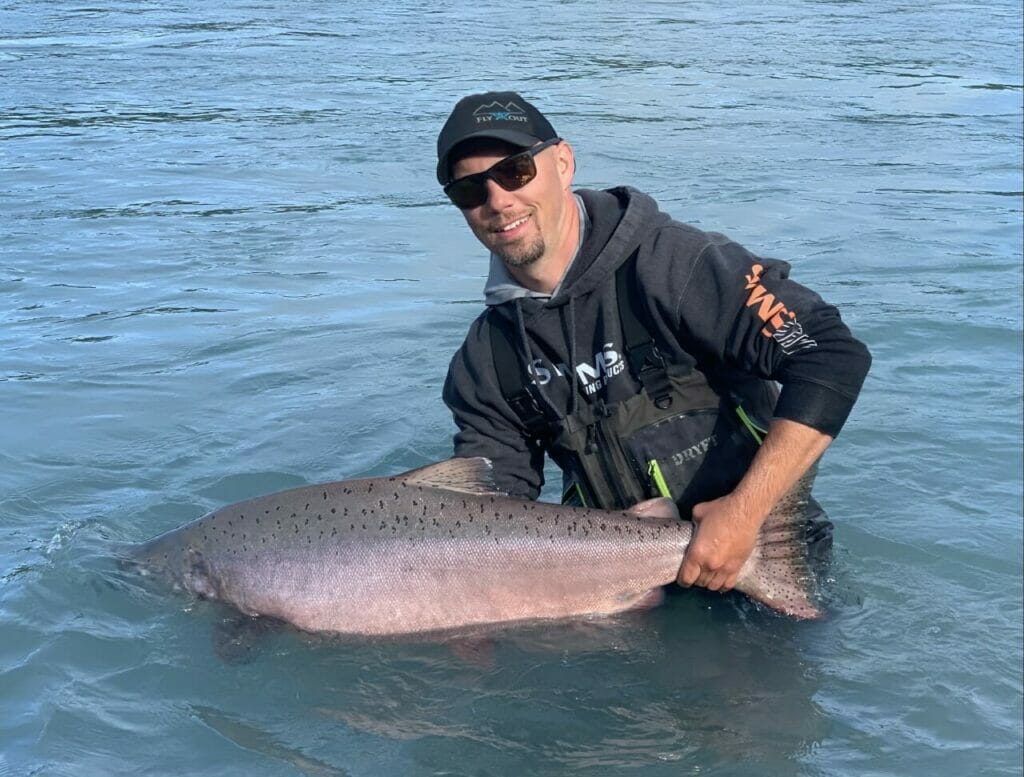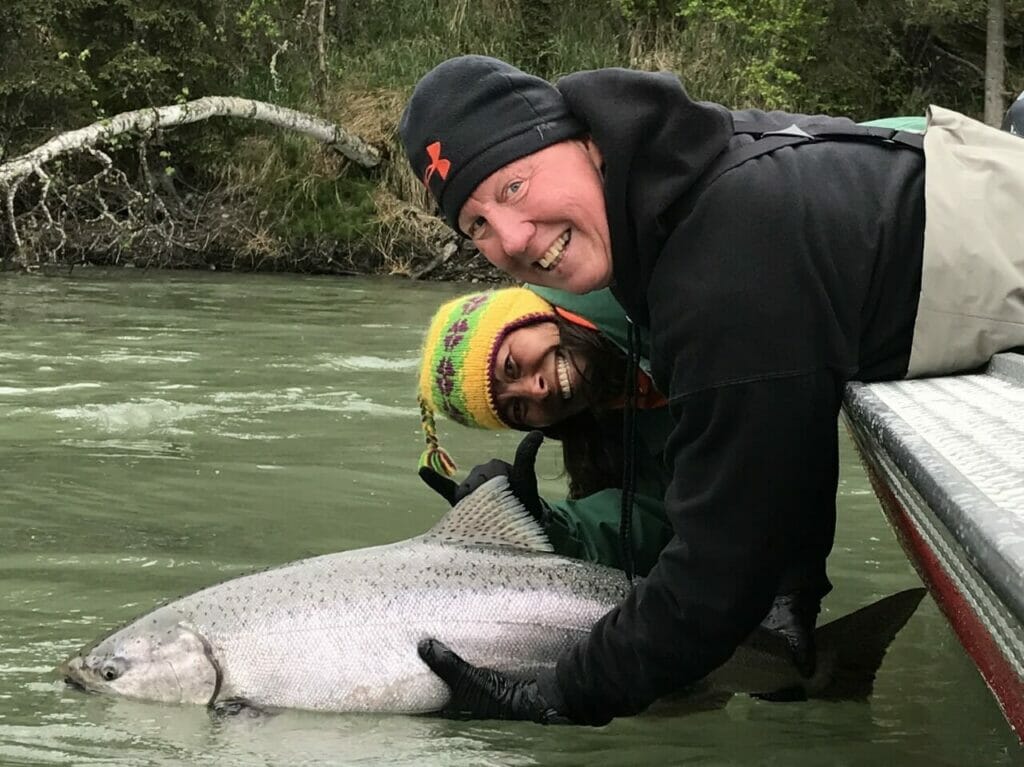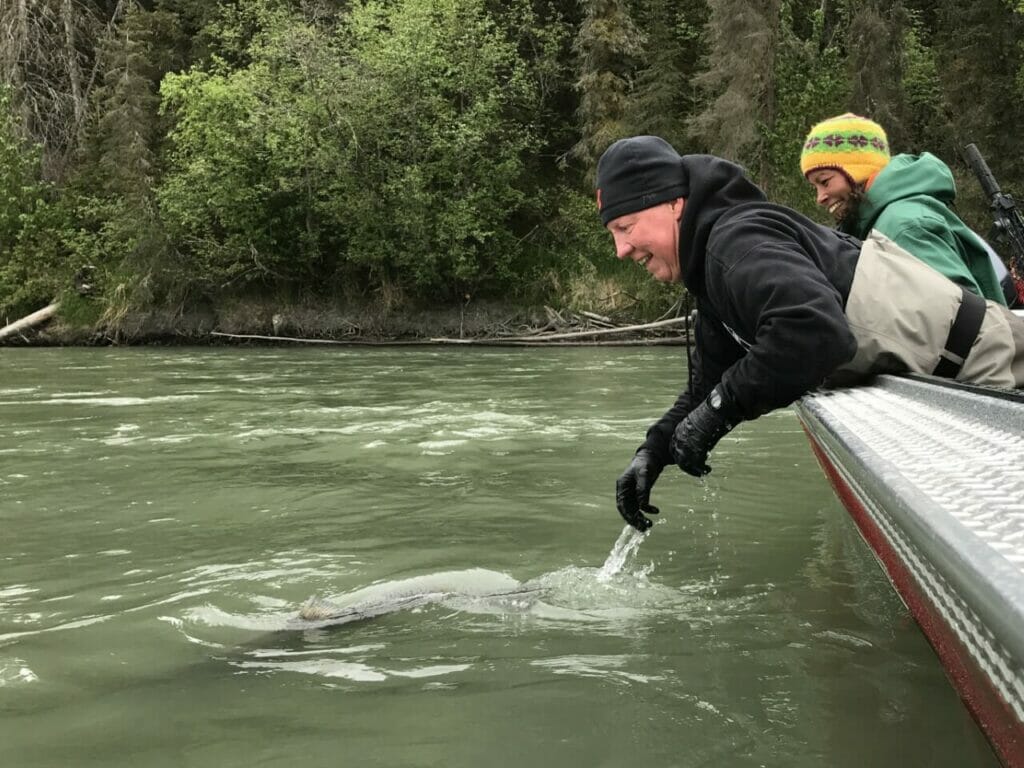Alaska salmon. These words alone fill an angler’s mind with wild rivers seemingly overflowing with anadromous invaders bound upstream to spawn the next generation, and chrome fish bigger and spunkier than an elementary student amped on sugar and caffeine. Wild Pacific salmon runs are struggling or altogether missing throughout their historic ranges, and Chinook salmon are their poster child.
While wild salmon runs in Alaska remain a source of hope in the otherwise tragic tale of a historically abundant, culturally and financially valuable resource falling to the void of short sightedness, concerns for the health of king salmon runs in many parts of Alaska are mounting. The conservation of Chinook is a top priority for many Alaskans, TU members included. Over the past several years a duo of Kenai River guides have committed themselves to making a big splash in Chinook salmon conservation for the sake of the fish.
Meet Fish for the Future, a team of two guides that is out to tackle the issue from a level in which every angler can play a role. Fish for the Future has made strides in educating fellow anglers and shifting the understanding of whose role it is to conserve Chinook. But don’t take our word for it. We will let them speak for themselves in the following interview.
You can follow FFTF on Facebook and Instagram (@fish4thefuture), visit their website to learn more about their mission and make a contribution here.
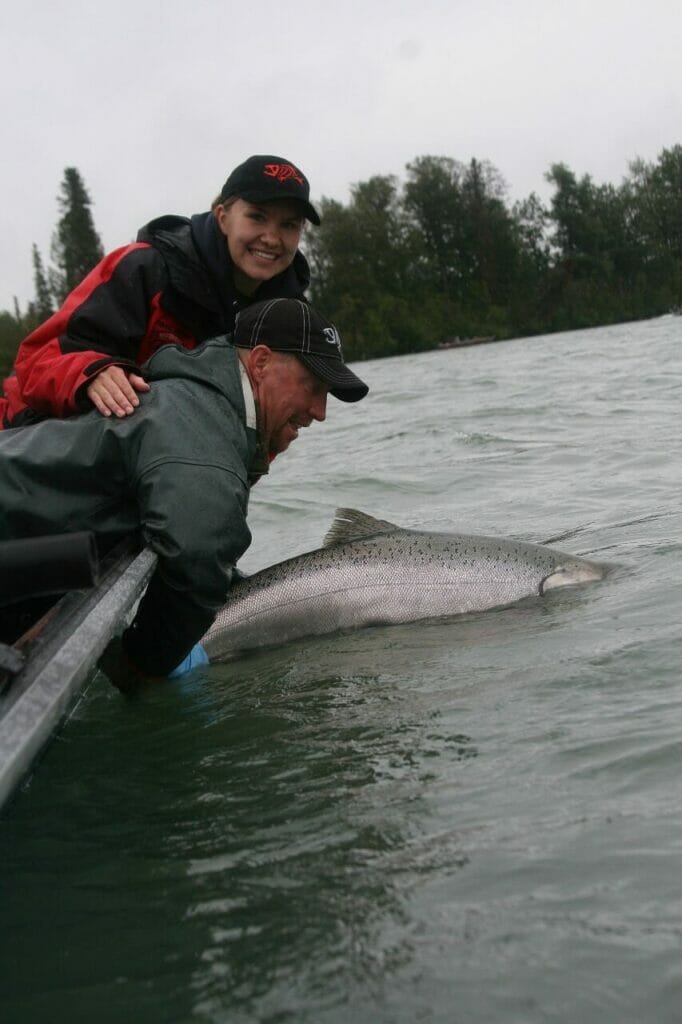
Guides, fathers, business owners — you both are certainly very busy, what was the impetus for adding Fish for the Future to your plate?
Mark: Frustration, mostly. Watching the quality and quantity of king salmon plummet, yet little to no change in the behavior of the users. Despite the reality that encountering a massive king salmon had become a rarity, the rate at which those fish were being harvested remained the same. Not only that, but virtually everyone was pointing at the “other guy” to blame for the downturn. On top of it all, the misinformation in the community was running rampant. I felt that an educational program that focused on self-accountability and put the fish first was much needed.
Greg: Good question. For me, there were several deciding factors.
One was the sheer sadness of watching Kenai king numbers decline and the size of our special fish shrink. Meanwhile, I continued to be part of the problem, rather than part of the solution. It got so bad that at one stage of my career, I no longer felt joy when my client caught and killed a big Kenai king salmon. I had trouble even sleeping some nights as I looked in the mirror and asked myself, “What are you doing?”
The other was the rampant misinformation about Chinook catch and release that constantly circulated. That was so frustrating.
Still another area of frustration was the division in our community that continued to spiral down as users chose “finger pointing” at someone else rather than asking themselves, “Could I also be to blame?” and, “What can I do?” all while watching king numbers and size decline.
The final impetus for starting Fish for the Future was rather selfish, because I just wanted my grandkids to have the opportunity to someday do battle with a huge wild salmon.
What is your most memorable fish?
Mark: I’ve netted some incredible fish over the years, but my most memorable fish was the last big king that I ever harvested. It was late July, which is typically the peak of the king run on the Kenai, and fishing was slow to say the least. However, every guide/angler has their lucky day and this one was mine. Despite the terrible fishing, my three clients had three big kings in the fish box, the third and final fish being an ultra-rare hen in the 55-plus-pound category. In the past, you wouldn’t have been able to slap the smile off my face after a day like that, but this time it was different. Rather than having a sense of pride in my accomplishment, I felt an overwhelming sense of shame at what I had just done. It was that day, and that fish, that was the catalyst for this movement.
Greg: That’s an easy one. Over the years, we’ve landed dozens of kings over 70 pounds on my boat. Each was unique, special and memorable.
But when a first-time king angler from Arizona actually chooses conservation of “the biggest of big” by voluntarily releasing a “once in 10 lifetimes” chrome-bright buck that measures 55.5 inches long with a girth of 33.5 inches … well, that’s gonna be a tough one to top.
By the way — with current king salmon catch-and-release formulas, that particular fish computes out to the low to mid-80 pound range and remains my personal best after 31 years of guiding full-time in Alaska. Best of all, I never heard of an 80-plus-pound Kenai king being caught and kept the rest of that season, almost guaranteeing that he made it to the spawning beds, successfully passing-on his unique genes.
As the largest Pacific salmon, the appeal of Chinook to anglers is understandable, but what is it about king salmon that capture you?
Mark: When you’re fishing the Kenai River you are fishing for the largest salmon on the planet, surrounded by the most talented salmon anglers on the planet. That gets me fired up.
Greg: Simply their size and power. Until one has hooked a tidal fresh salmon of 50, 60 or seventy pounds, it’s hard to describe.
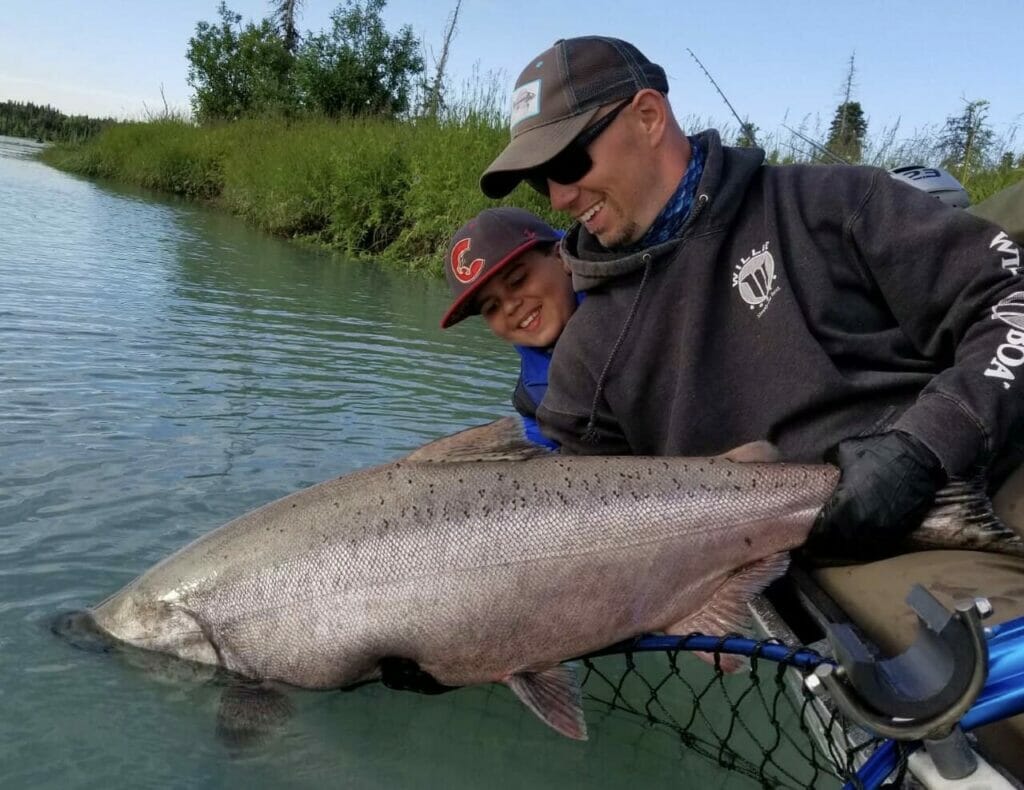
What concerns you most about recent king salmon return trends?
Mark: The Kenai River has historically gone through periods of low abundance, but this is something different. This period is lower than anytime in recorded history, and it has lasted longer than it should. In addition, the five- and six-year ocean Chinook that make the Kenai River stand out from the rest have become exceedingly rare. This kind of trend warrants much concern, and big changes.
Greg: The decline in total numbers and the ever-shrinking five-ocean component in both the early and late runs. Little known fact: the percentage of giant five-ocean to 7-year old Chinook in the Kenai currently makes up less than 1 percent of the return according to ADF&G data.
For our members across the nation who are less familiar with wild king salmon and unfamiliar with the Kenai Peninsula — why FFTF? What sets you apart?
Mark: Fish for the Future is different because we put the fish first, period. We don’t represent any user groups; we don’t point fingers or play the blame game, and we don’t have a special interest — unless wanting to see more big, wild king salmon on the spawning beds counts as a “special interest.”
Greg: Well, we are entirely focused on Kenai and Kasilof River king salmon conservation.
That’s certainly unique, but what I think sets Fish For The Future apart and has been instrumental in our growth is the fact that we remain non-divisive and non-allocative in all that we do and all that we say.
Quite simply, we stay in our lane, asking folks to please consider facts in the form of hard data derived from numerous scientific studies when they form an opinion, and then maybe consider choosing catch and release when you finally land a big, wild king salmon.
It’s all about respect, choice and personal responsibility, rather than finger-pointing. This approach has never been tried in our area and it’s refreshing how many people have embraced it.
We think that the public was ready for something positive, something constructive — and participation and support of the program supports that belief fully.
Why partner with Trout Unlimited?
Mark: TU was a natural partner for FFTF. There are many similarities in the missions, and TU’s reputation and influence provides additional credibility to assist in Fish for the Future’s short- and long-term goals.
Greg: For decades, Trout Unlimited has remained laser-focused on their mission, too; namely conservation, conservation, conservation. By partnering with Trout Unlimited, our grassroots FFTF effort can not only learn what works and what doesn’t, but also grow, and growth is key to any outreach program, especially one that is education-based.
What is the No. 1 action you would encourage individuals to consider for supporting the conservation of Chinook?
Mark: Stop blaming the other guy. Control what you can control. Take responsibility for your own actions. The sooner we all do that, the better chances these fish have.
Greg: Please consider catch and release of big wild kings as the proven management tool that it is, even if it isn’t required by regulation. And maybe focus your harvest efforts on those species that are more abundant, like sockeye salmon. (Oops, that’s two actions, isn’t it?)
It got so bad that at one stage of my career, I no longer felt joy when my client caught and killed a big Kenai king salmon. I had trouble even sleeping some nights as I looked in the mirror and asked myself, “What are you doing?”
Greg Brush, Fish for the future
Are there any recent successes for FFTF that you are most proud of?
Greg: Too many to list here, but one that comes to mind immediately is an example of how remaining respectful and positive 24/7 can influence even the hardest to reach person.
There was this long-time, veteran king salmon guide that often blamed the “other user” as the reason for our big king decline. He participates in catch and release, when regulations required it, but other than that, continued to harvest the very fish that he built his business on and deeply loved.
The first few years of Fish for the Future, he showed us to be a rather outspoken skeptic of our program, but slowly, little by little, he came around.
Three years ago, we noticed that he started “liking” a few king salmon release photos on our Facebook page. Two years ago, he chose to comment on some. And last year, he actually submitted some ethical release photos. Now, he is a big fan, spreading the word of our program and even advocating for more catch and release of big, wild Kenai kings. How cool is that?
Throughout their native range, Chinook salmon are struggling, and many are extinct. How would you like the Kenai and Kasilof runs to look 20 years from now?
Mark: I would love to see these rivers creep their way out of the current extended period of low abundance, and to see their unique genetics exist in perpetuity. If and when we get there, I hope that even during periods of high abundance we remember just how special and unique these king salmon are, and that we learn to harvest in a responsible way that continues to provide fish for the future.
What’s your all-time favorite salmon recipe? (For species other than wild Chinook that is!)
Mark: “Soy Salmon” is a recipe I learned from my dad, and it works great with both fresh salmon as well as those fillets you pull from the depths of your freezer in the middle of winter.
- Cut your fillet into portion-sized pieces and place in a large pan.
- Add minced garlic on top, or sprinkle with garlic salt.
- Add a 1/1 mixture of soy sauce and water so that the liquid covers about half way up the fillet; about 1 cup of each usually does the trick.
- Cover and cook over a medium flame.
- In a separate pan, super-heat a couple tablespoons of olive oil.
- When the fish is almost done, turn off the flame and then drizzle the super-heated olive oil over the fish pieces.
- Add chopped green onions on top.
- Serve with French bread (the soy sauce mix makes a great bread dip!)
Greg: Make no mistake: we love eating salmon, even kings. We just focus our harvest on hatchery fish whenever possible or those Chinook that come from mixed stocks and/or healthy runs.
With that said, my shore lunch is an epic taste treat for even those visitors that claim to “hate salmon” because it was too fishy tasting.
Take an uber-fresh sockeye salmon fillet, rinse and pat it dry, then BBQ it skin down on a sheet of foil (uncovered, but closed lid) on a preheated grill of about 400 degrees.
Being health conscious, my wife prefers a super-lite coat of olive oil prior to sprinkling dill, garlic powder and lemon-pepper on it, but in my opinion, a dab of “old school” butter is hard to beat!
Grill only until the layers in the fillet begin to open and flake a bit, whereas the coloration is two-tone with the middle being lighter and moister than the surface. Do not over-cook it — that’s the biggest mistake people make. Rather, get it off the heat when it is almost done, remembering that it will continue to cook a bit even after being removed from the grill.
That’s it; simple, easy and utterly fantastic tablefare that can’t be topped. Enjoy!
In 2020 a fiscal sponsorship was established between TU and Fish for the Future. As a result, individuals and businesses can now make a tax-deductible contribution to FFTF to help further their good work to educate guides and salmon anglers on how they can play a role in conserving Chinook (king) in Alaska’s famed Kenai and Kasilof rivers. Make your contribution to Fish For The Future here.


